GRG Resources ...
Last updated on Tuesday, June 16, 2015

- February 18, 2014; (The Scientist) - - Here's a curious photo of an apoptotic cell
from an aggressive cancer line; as HeLa Cells die, they produce characteristic spikes
and rounded blebs on their surfaces...
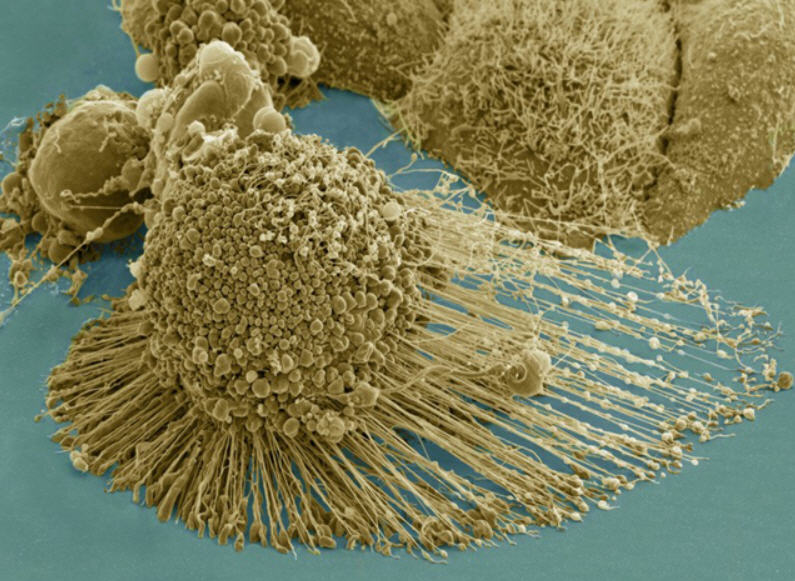
-
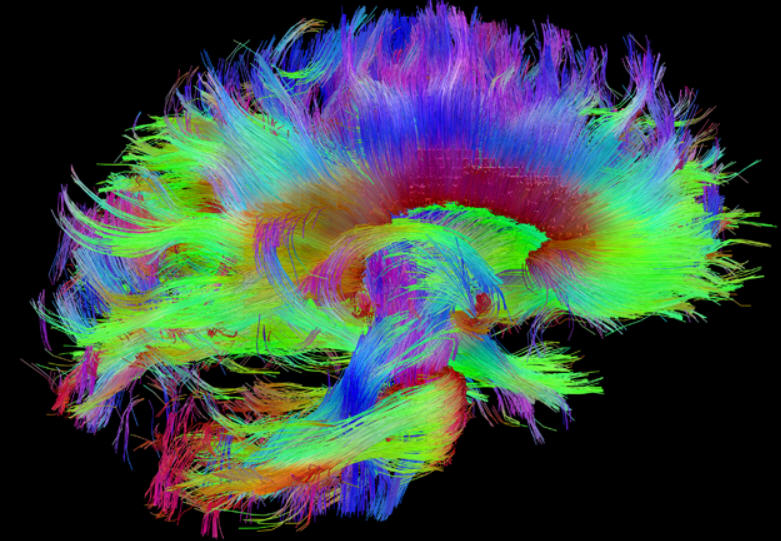
June 24, 2013; Brain Fibers: The white matter fibers of the human brain are tracked with
Diffusion Tensor Imaging.
-
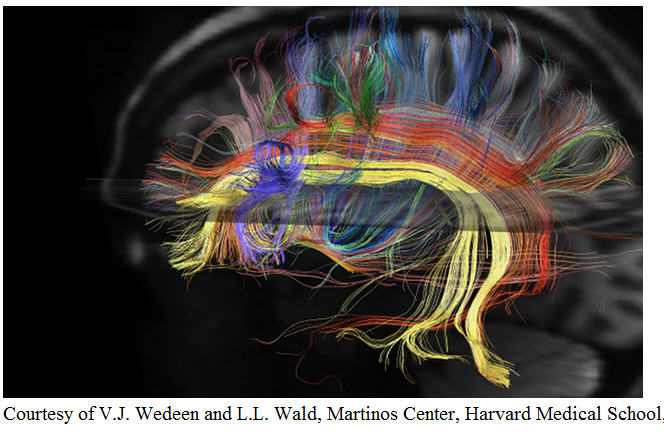
February 20, 2013; (The Scientist) - - Neural pathways form a mesh, with yellow
representing language and connecting the frontal lobe on the Left to the temporal lobe on the
Right, and the purple curlicue representing Broca's Area that has the job of coordinating speech
(tongue, lips, throat, vocal folds, and diaphragm muscles).
Click on the photos above for more details on the Human Connectome Project.
One of the key participants is
LONI (Laboratory of Neural Imaging) at UCLA and now USC.
Note: Prof. Arthur W. Toga, Ph.D. left UCLA with his team to join the USC Keck
School of Medicine last September 2013.
-
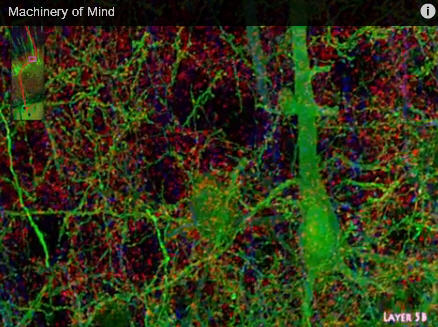
Thursday, November 14, 2013; At Stanford University's Department of Physiology, Prof.
Stephen J. Smith has been working on a new technique for high resolution scanning of the mouse
brain called Array Tomography . He and his team have created a new YouTube video
called "Machinery of the Mind" (TRT = 2:18 min.) with Introductory MRI Data from
Brookhaven National Lab that was set to spooky music (by Catherine Rose Smith) intended
presumably to emulate the buzz of the EEG (from all the synapses firing, whether awake or
asleep). Remember, there are no sounds in outer space despite the swishing sound you hear when
a rocket ship blasts away from a space station in Sci-Fi movies, nor is there music going on in the
brain when synapses are firing. Nevertheless, you are led through multiple layers of cortex
panoramically from top to bottom. The complexity of what you're looking at is really
scary if you originally thought that the brain was a simple textbook model of neurons connected
like the computer simulations of neural networks from good old days (1990's). As you can now
see, there are thousands of dendrites connecting axons, not just a dozen or so. Click on the
photo above to watch
the video at
The-scientist.com/Cortex-Tour.
Additional clips are available at
Smith Lab.
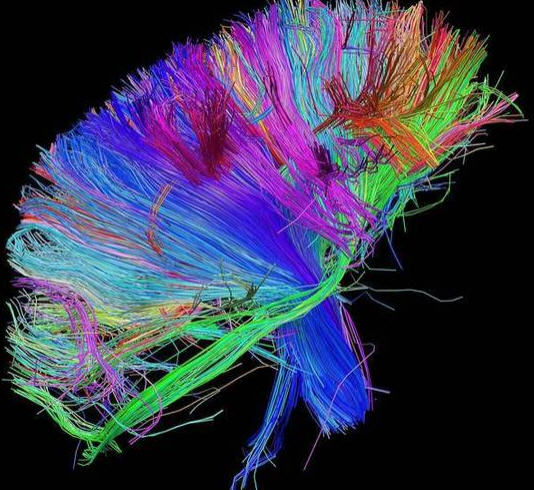
Sunday, March 17, 2013; Click for details of a
A brain scan of white matter fibers,
color-coded by direction.
(Courtesy of the Laboratory of Neuro Imaging at UCLA and Martinos Center for Biomedical
Imaging at MGH September 5, 2012)
- Friday, November 30, 2012; Click for a series of nine one-hour lectures entitled
"Introduction to Gerontology," video recorded by the UCLA Office of Instructional Development
(OID)
Chem-19-2.
- Thursday, October 4, 2012; 4:00 PM PDT; Click for a short, extraordinary
video-clip of mitosis in a
Drosophila S2 cell expressing GFP-Ndc80, GFP-gamma tubulin, and mCherry alpha tubulin.
Time lapse photography images were recorded at 60 second intervals using a spinning disc
confocal microscope on a Nikon TE-200 stand with a 100x 1.4 NA Plan APO DIC objective lens
and recorded with a Hamamatsu Orca-ER CCD camera. Note the oscillations of the Mitotic
Spindle Apparatus at the end of Metaphase but before the rapid sister-chromatid separation
occurs in Anaphase. This requires both a forward and a reverse kinase protein infrastructure.
Why does Nature need such an expensive pulley system? Is it to ensure that all chromosomes are
connected to their own tubule before there is a "go" signal to start sister-chromatid separation?
One wonders why eukaryotic cells evolved so as to do this at all, and why it works so often
without pathological trisomies. A single non-synonymous mutation in one of the kinekore-
protein genes would be lethal, since they are on the critical path for all mitotic divisions.
- Wednesday, September 12, 2012; 3:00 PM EDT; Click for a presentation at NIA/NIH in
Bethesda, MD, entitled
Is Aging Reversible? Resetting the Clock by Prof. Thomas Rando, M.D., Ph.D.
of Stanford University School of Medicine (TRT = 62:40 min).
-

A nerve ending that has been broken open (and stained) to reveal the synaptic vesicles inside.
The Candida Diet.
- July 25, 2012; Click for Glybera, a newly-approved in Europe gene therapy for
LPL, a Lipoprotein disorder, with a beautifully-done animation of the general process of genetic
engineering.
August 1, 2012; Click for three PBS-TV videos by Ray Kurzweil on the prospect for immortality in our
life times..
- July 17, 2012; Click for the US Genome Institute's current cost of DNA sequencing
www.genome.gov/sequencingcosts
- July 20, 2012; Click for a comparison of next generation sequencers.
- July 16, 2012; Click for a view of smart nanoparticles destroying a blood clot at Harvard University. (TRT = 19 sec.)
- June 12, 2012; Click for an Australian animaiton on the subject of Synthetic Biology (TRT = 6:36 min.).
- April 26, 2012; Click for a Flash Animation of
Scope of the Universe , a video assembled by a pair of 14 yo twin brothers; TRT = 6:25
min. This animation will give students of gerontology a feeling for the vast dynamic range {from
atoms and molecules to organelles, cells, tissues, organs, subsystems, and our largest Earthly
creatures, whales} about 10 orders of magnitude, in which Darwinian stochastic processes have
been operating on our relatively undistinguished planet for more than five billion years. Aging
and senescence can take place at any one of the ten levels.
- May 12, 2012; Click for a "History of the Universe" compressed into one year . Interesting things from our point of view don't happen
until the last second of the last hour of the last day of the last month.
.
- May 12, 2012; Click for a scan of a small portion of a
mouse brain , in a false-colorized video (to the accompaniment of classical music) that
reveals the complexity of the mammalian brain in unprecedented detail (as published by Stephen
Smith of the Department of Molecular and Cellular Physiology at Stanford University in the
journal Neuron (2010). (TRT = 4:26 min.)
.
- May 18, 2012; Click for a zooming-out video animation from the
The Human Brain Project, with random clusters of synapses firing (but this time without
accompanying of music). It also reveals the complexity of a hypothetical mammalian brain in
unprecedented detail. (TRT = 1:33 min.)
.
- April 12, 2010; Click for the Folate
Newsletter by Karlis Ullis, M.D. and Critiana Paul, M.S. in Nutrution
- Click for "In Pursuit of the Longevity Dividend: What Should We Be Doing To Prepare for
the Unprecedented Aging of Humanity?" by S. Jay Olshansky, Ph.D., Daniel Perry, Richard A.
Miller, M.D., Ph.D., and Robert N. Butler, M.D.;
The Scientist
(March 2006).
- Click for a Letter-to-the-Editor in
Science on Anti-Aging
Medicine published in the April 26, 2002 issue. Most of the seven co-authors are active members
of the GRG.
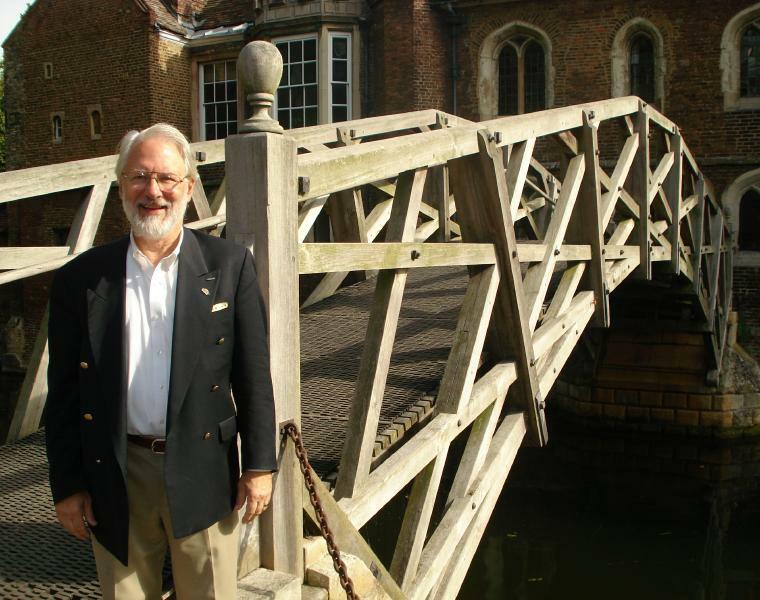

Click on either of the photos above for 41 PowerPoint slides on
"The Secrets of the Oldest Old". [Microsoft browser
Internet Explorer ver. 7.0.6 or above preferred.] This presentation was given by L. Stephen
Coles at the SENS-3 Conference at Queen's College, Cambridge University; UK on
Thursday, September 6, 2007; [3:35 3:50] PM GMT.
- Prof. Kathrin Plath's PowerPoint Slides in PDF format
on the topic of "Reprogramming Somatic Mouse Cells to Form Pluripotent Stem Cells
without Embryos."
- Click for Jon Eisenberg's Chart entitled, Philanthropy Roundtable, revealing the inter-relationships among the
various funding sources who facilitated Florida state and Federal lawsuits for the Schindler
family on behalf of maintaining Ms. Terri Schiavo on life support indefinitely and, in particular,
by not removing her feeding tube on the grounds that she was in a potentially reversible
long-term coma and not in an irreversible Persistent Vegetative State (PVS)
(with no sign of a cortical EEG). (There is an intriguing intersection between this Chart and the
funding of a lawsuit opposing the implementation of California Prop. 71 on Stem Cells in the
Superior Court of Alameda County.) Three recent books on the topic of Ms. Schiavo are as
follows:
1. Jon Eisenberg, Using Terri: The Religious Right's Conspiracy to Take Away Our
Rights (Hardcover; 288 pages; ISBN: 0060877324; Harper, San Francisco, CA;
2005; $15.72 on Amazon.com).
Comment: "If you care about preserving your right to control how you die this book
will prove to be vital reading." -- Prof. Arthur Caplan, The Emanuel and Robert Hart Professor
of Bioethics, Chair of the Department of Medical Ethics, and Director, Center for Bioethics
University of Pennsylvania.
2. Michael Schiavo and Michael Hirsh Terri: The Truth (Hardcover; 384 pages;
ISBN: 0525949461; Dutton Adult, New York; 2006; $15.72 on Amazon.com).
3. Mary and Robert Schindler, Bobby Schindler, Terri's Family, and Suzanne Schindler
Vitadamo, A Life That Matters: The Legacy of Terri Schiavo -- A Lesson for Us All,
(Hardcover, 272 pages; ISBN: 0446579874; Warner Books, New York; 2006; $15.57
on Amazon.com).


Click on either of the photos above to review the 29 PowerPoint slides of the Autopsy of
California Supercentenarian, Mr. George Johnson, 112 yo World War I Veteran performed at the
Palo Alto VA Hospital, presented by L. Stephen Coles at Noon on Saturday, November 11th at
The Age Management Medicine Conference at the Red Rock Hotel and Casino in Las
Vegas, NV.
Click to view the 28 PowerPoint slides presented by
Prof. S. Jay Olshansky of the University of Illinois at
the Longevity Dividend Conference on Tuesday, September 12, 2006 at 11:30 AM EDT
at the Hart Senate Office Bldg. in Washington, D.C. sponsored by
The Alliance for Aging Research
to an audience of about 60 persons. Jay made it clear that, although he believes that stopping or
reversing human aging is still practically impossible, he and some of his colleagues now endorse
the prospect of slowing the aging process through various types of medical interventions. Jay
and the next speaker, Prof. Leonard Guarente of MIT, addressed the topic of "How Soon before
Science Can Slow Aging and at What Cost?"

Click on the photo of the King Frederick II's Palace [1296 - 1336] above (which is the oldest
building still standing in Palermo with its original Roman arches preserved inside) to review the
39 PowerPoint slides now containing photos taken at The Third International
Conference on Functional Genomics and Aging, [March 29th - April 1st] in Polermo, Sicily;
ITALY on the topic of "Why Supercentenarians Live So Long?" by L. Stephen Coles.
-

Click on the photo of Jay P. Sharma, CEO of Celprogen, Inc. for the 23 PowerPoint
slides from our January 2006 LA-GRG Guest Lecture at UCLA on "Synchronized Contraction of
Differentiated Cardiomyocyte Stem Cells Derived from Tissue Culture."
-
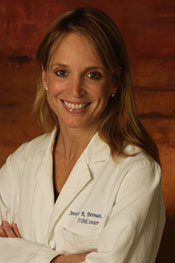
Click on the photo of Dr. Jennifer R. Berman, M.D. for her 47 PowerPoint slides from
our February 2006 LA-GRG Guest Lecture at UCLA on "Female Sexual Medicine."
- Click for our recommended list of legitimate studies, published in reputable peer-reviewed
scientific journals by established researchers, that employ the term
Anti-Aging" to describe the
attempted postponement of chronic age-related diseases.
- Catalog of Journals on Aging from
Rutgers University
- Chapter 1 --
Introduction to a new book by Henry J. Aaron and William B. Schwartz, Eds.
entitled Coping with Methuselah: The Impact of Molecular Biology on Medicine and
Society in pdf format. This is a very well written text published by the Brookings Institution
( ISBN: 0815700407; 2004).
-
Science Magazine article on the "Genetics of Aging" by C. E.Finch and R. E.
Tanzi
- JAMA
article (Vol. 278. No. 16, pp. 1345-1348; October 22/29, 1997) on
"Telomeres, Cancer, and Aging: Altering the Human Life Span" by Dwayne A. Banks, Ph.D. and
Michael Fossel, M.D., Ph.D.
-
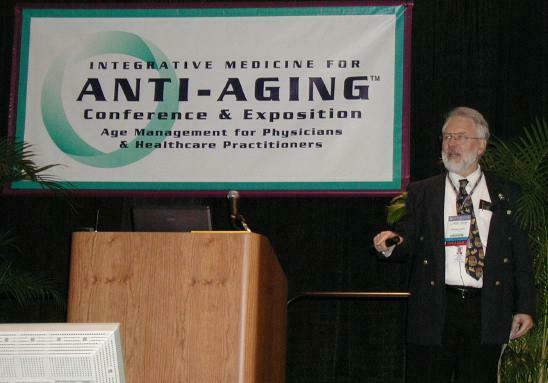
Click on the photo for 121 PowerPoint slides taken from the presentation on
Bioethics for Anti-Aging Medicine
by L. Stephen Coles, M.D., Ph.D. presented at the 2nd Annual East-Coast Primedia
Anti-Aging Conference held at the Palm Beach Convention Center in Palm Beach, FL on
Saturday Morning, November 19, 2005; [8:45 - 10:15] AM EST). The audio and video clips
linked to the PowerPoint slides have been deleted to conserve on bandwidth. A full VHS Video
Tape is available upon request. Click to obtain your free copy of the Howard Hughes Medical
Institute DVD on "Ethics in Biomedical
Research."
-

Click on Stan's photo for the PowerPoint slides on the Supercentenarian Research
Foundation by Stanley Primmer, Elliot Bergman, and L. Stephen Coles presented at the
34th Annual Scientific Meeting of the American Aging Association (AGE) in Oakland,
CA (Saturday, June 3, 2005 [5:30 - 6:30] PM PDT).
- Click for the text
that goes with these slides.
- Position
Paper on Human Therapeutic Cloning by L. Stephen Coles (65 pages; April 15,
2002)
- CoEnzyme Q-10, Lifespan
Extension, and Oral Supplementation Problems" a 38-slide
PowerPoint-Presentation by Dr. Steven B. Harris, M.D. presented to the GRG at UCLA on
Monday night, April 11, 2005.
-
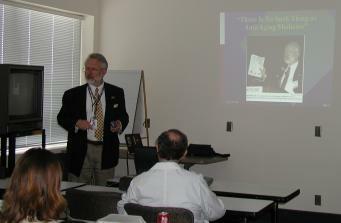 77-slide PowerPoint-Presentation (but without video clips) of Dr. Stephen Coles's
talk on "Ethical Challenges in Anti-Aging Research --
Profits vs. Science" presented on Tuesday, March 16, 2004 at a Noon-time Seminar on
Medicine, Ethics, and Human Values at the Santa Monica UCLA Medical Center (best viewed in
Microsoft Internet Explorer 6.0 or greater). Click on the photo for the slides.
77-slide PowerPoint-Presentation (but without video clips) of Dr. Stephen Coles's
talk on "Ethical Challenges in Anti-Aging Research --
Profits vs. Science" presented on Tuesday, March 16, 2004 at a Noon-time Seminar on
Medicine, Ethics, and Human Values at the Santa Monica UCLA Medical Center (best viewed in
Microsoft Internet Explorer 6.0 or greater). Click on the photo for the slides.
 90-slide PowerPoint-Presentation (including background slides but, due to
bandwidth limitations, without audio or ten video clips) from Dr. Stephen Coles's talk on "What Can We Learn from Supercentenarians? The
Implications for Human Longevity" the first part of which was presented on October 31,
2004 at the 12th Congress of the Anti-Aging Medicine at the Hilton Hotel in Las Vegas (Revised
on November 24, 2004).
90-slide PowerPoint-Presentation (including background slides but, due to
bandwidth limitations, without audio or ten video clips) from Dr. Stephen Coles's talk on "What Can We Learn from Supercentenarians? The
Implications for Human Longevity" the first part of which was presented on October 31,
2004 at the 12th Congress of the Anti-Aging Medicine at the Hilton Hotel in Las Vegas (Revised
on November 24, 2004).
There is also a 44-slide PowerPoint Presentation entitled
"Nutritional Supplements: The
Scientific Data" that was presented in San Francisco on September 29, 2002 (revised on
September 17, 2004 and November 10, 2004). In particular, in Slide 18 regarding Vitamin E
(Alpha Tocopherol), we have withdrawn our prior recommendation of [400 - 800] iu qd based on
a report from Johns Hopkins of increased mortality of 5 percent at these higher doses. We now
recommend only 150 iu qd.

Furthermore, on April 20, 2005, the US Department of Agriculture has issued a new Food
Pyramid. If you click on the icon above, you can link to a much larger poster-quality version (in
pdf format) that can then be printed out on a color printer for wall mounting.
The new pyramid is actually 12 different pyramids indexed by age, gender, and level of physical
exercise on a typical day that needs to be customized for each subject at the
USDA website.
The two presentations above taken together replace slides from four previous talks as follows:
(1) a Symposium on Anti-Aging Skin in May 2001 in San Diego;
(2) "Ten Unsolved Problems in Anti-Aging Medicine" presented on December 15, 2001 at the
annual A4M Conference in Las Vegas;
(3) "Why Do Centenarians Live So Long?" presented at the Longevity Boot Camp on
April 27, 2002 in Las Vegas, and
(4) a talk given at the Annual Plastic Surgery Conference on May 27, 2002 in Rancho Mirage.
(These presentations can at last be viewed in either Microsoft's Internet Explorer
6.0.2 or Netscape Navigator 7.2 or greater. It was not always the case that the
Netscape browser could show PowerPoint slides in html format.)
- 59 PowerPoint Slide Presentation "The 90+ Study: A Population-based
Study of the Oldest Old" by Prof. Maria M. Corrada of the University of California at Irvine
given at the UCLA LA-GRG Meeting on Monday, August 9, 2004. (Best viewed in Microsoft
Internet Explorer 6.0 or higher)
- 84 PowerPoint-Slide Presentation
"Overview of Concepts in Anti-Aging
Medicine" by Brian M. Kinney, M.D. presented at the American Society of Plastic
Surgeons Annual Meeting in Rancho Mirage, California on Memorial Day, May 27, 2002
(Best viewed in Microsoft Internet Explorer 6.0 )
- 17 PowerPoint Slide Presentation
"Problems with the Theory of
SuperCentenarians" by Mr. Robert Young presented at Supercentarian Workshop
in Atlanta, Georgia on May 8, 2002 (Best viewed in Microsoft Internet Explorer 6.0
)
-
64 PowerPoint Slide Presentation
of Dr. Karlis Ullis's Talk on Sex Hormones in Aging Skin in San Diego on May 18,
2001 (Best viewed in Microsoft Internet Explorer 6.0 )
-
38 PowerPoint Slide Presentation of Stephen Coles's O2SA Talk in Maui,
Hawaii
on April 3, 2001 (Best viewed in Microsoft Internet Explorer 6.0 )
 Chapter 48
"Epidemiology of Antioxidants in Cancer and Cardiovascular Disease;" by Dr. L.
Stephen Coles in SECTION 7 EPIDEMIOLOGY AND INTERVENTION STUDIES of the
new textbook Oxidative Stress and Aging: Diagnostics, Intervention, and Longevity,
Edited by Richard G. Cutler and Henry Rodriguez, pp. 821-844 (World Scientific Publishing
Company, Ltd.; Singapore; 2002); Proc. of the Second International Conference on
Oxidative Stress and Aging, Technologies for Assessment and Intervention Strategies (April
2-5, 2001; Maui, Hawaii). Click the photo of the book cover to access this chapter.
Chapter 48
"Epidemiology of Antioxidants in Cancer and Cardiovascular Disease;" by Dr. L.
Stephen Coles in SECTION 7 EPIDEMIOLOGY AND INTERVENTION STUDIES of the
new textbook Oxidative Stress and Aging: Diagnostics, Intervention, and Longevity,
Edited by Richard G. Cutler and Henry Rodriguez, pp. 821-844 (World Scientific Publishing
Company, Ltd.; Singapore; 2002); Proc. of the Second International Conference on
Oxidative Stress and Aging, Technologies for Assessment and Intervention Strategies (April
2-5, 2001; Maui, Hawaii). Click the photo of the book cover to access this chapter. - 90
PowerPoint Slide Presentation of Dr. Alfred J. Koonin's Talk on "The
Antioxidant
Effects of Ultra-Low Microcurrents" given on February 12, 2001 [ Warning: The slides at the end of this talk are highly
graphic depictions of severe skin lesions and wounds in various stages of healing.] (Best viewed
in Microsoft Internet Explorer 5.0 )
-
65 PowerPoint Slide Presentation of Stephen Coles's Extropy III Conference Talk
in San Jose, California (Best viewed in Microsoft Internet Explorer 5.0 )
- 40 PowerPoint Slides
of Dr. Michael Fossel's talk on "Reversing Human Aging" to the GRG on Aug. 11,
1997.
- Prof. John H. Campbell's
talk on "A Vision of Human Germline Engineering" to the GRG on Aug. 10, 1998
- 20 Slides of
Prof. Michael Rose's talk on "Aging: A Target for Germline Engineering" to the GRG on Sept.
14, 1998.
- 43 Slides of
Dr. Steven M. Kaye, M.D.'s talk on "Improvement of Balance through Vestibular Rehabilitation:
Balance Retraining Can Result in a Significant Reduction of Injuries Due to Falls in the Elderly"
to the GRG on Dec. 14, 1998.
- 70 Slides taken from Prof. Bruce Ames's talk on
"Oxidative Stress" to The Kronos Group in Phoenix, Arizona on February 19, 2000. [Best
Viewed in Microsoft Internet Explorer 5.0 ]
- 54 Slides on the Evolution of Infectious
Disease given to a AAAS Meeting in Anaheim, California (Saturday, February 1999). [Best
Viewed in Microsoft Internet Explorer 5.0 ]
- Slides of 30 Books
on Genetics and Cloning
- Unfortunately, Phil Green (University of Washington) has deleted his lengthy response to
the "Jason Report on the Human Genome Project" (Prof. Steven Koonin of CalTech was our
guest speaker in April 1998) from his web site
- The
caloric-restriction research of Prof. Roy Walford
- Journal of
Anti-Aging Medicine
- Top Ten
Unsolved Problems in Aging
- George Duve of Hamburg, GERMANY has contributed a
short essay on his view of a Theory
of Aging
- GRG White
Paper on the Theories of Aging
- How Does
Aging Affect Your Body? from Seniors' Health (January 2000)
- Other
Gerontology-Related Web Sites of Interest
- Physicians
Specializing in Anti-Aging Medicine
- Short
Glossary of Technical Terms in BioGerontology
- Brief Glossary of Technical Terms in Stem-Cell Biology
- Proposed Five-Day Course for Physicians on
Anti-Aging Medicine
- Radio Interview with the BBC World News on Thursday,
November 12, 1998.
-
Prof. Leonard Hayflick, Ph.D.; Department of Anatomy; UCSD School of Medicine, Chapter:
"Modulating Aging, Longevity Determination, and the Diseases of Old Age,"
Modulating Aging and Longevity, pp. 1-15, S. I. S. Rattan, Ed. (Kluwer Academic
Publishers; 2003).
- A short version of The Bridge Plan
GRG Recommendations
for what we should be doing in the mean time, while we're all waiting for that big breakthrough
in Anti-Aging Medicine.
- Click for the full version of the Bridge Plan
GRG Recommendations.
This 48-page document provides our life-style and supplement recommendations, first published
in 1996 and revised continuously since then, as to what we should be doing while we're all
waiting for the predicted breakthrough in Anti-Aging Medicine. This current version was revised
on August 3, 2012.
- Click for the Maximum Life Foundation's
SALADS Document by David Kekich
(61 pages).
- International
Academy of Alternative Health and Medicine
- Alliance for Aging Research in Washington, D.C. Daniel
Perry, Executive Director; 2021 K Street, NW, Suite 305; Washington, D.C. 20006; Voice:
202-293-2856; FAX: 202-785-8574. Founded in 1986, The Alliance for Aging Research is a
non-profit organization promoting a broad agenda of scientific research on human aging.
- University of
Malta Institute of Gerontology
- "Gene
Expression as a Function of Age" Figure submitted by Stan Primmer

"Is Aging Another Disease?" by Michael Darwin (August 10,
2013)
August 3, 2013;
Here are the 27 elements that compose the human body taken from The Periodic Table
in order of descending body weight (our cosmic recipe derived from star dust) [1,2]. For interest,
elements that are toxic have been added in the next section.
Essential Elements:
Atom Percent by Weight Full Name
1. O 65.0 oxygen
2. C 18.5 carbon
3. H 9.5 hydrogen
4. N 3.3 nitrogen
5. Ca 1.5 calcium (in bone)
6. P 1.0 phosphorus (in phosphates)
7. K 0.4 potassium
8. S 0.3 sulfur
9. Cl 0.2 chlorine (in salt)
10. Na 0.2 sodium (in salt)
11. Mg 0.1 magnesium
12. I * iodine (in thyroxin T3, T4)
13. Fe * iron (in hemoglobin)
14. Zn * zinc (in carbonic anhydrase)
15. Co * cobalt (in Vitamin B12)
16. Mn * manganese (in SOD)
17. Cr * chromium (in picolinate)
18. B * boron
19. Ni * nickel
20. V * vanadium
21. Sn * tin
22. Si * silicon
23. Mo * molybdenum
24. Cu * copper
25. F * fluorine (fluoride placed in municipal water supplies to strengthen tooth enamel)
26. Li * lithium (contaminates some water wells in the form of lithium carbonate and is now used
for Rx: Bipolar Disorder)
27. Se * selenium (only at low doses; see Toxic Table)
________________________
* Only trace amounts (< 0.1 percent); some mineral elements are essential while the value of
others (or their dosages) in human nutrition has not been established. Conversely, too much of
some of these minerals - - like manganese, chromium, or selenium - - can also be toxic or even
fatal.
Toxic Elements:
Here are 42 toxic elementts and/or isotopes. Many toxic elements are fatal if inhaled or ingested,
but even a compound as simple as Carbon Monoxide (CO) [an odorless, colorless gas] becomes
fatal when inhaled inadvertently. Many heavy elements are toxic due to their weight. Many of
these have isotopes that are toxic due to their radioactivity...
Atom Full Name
1. Pu plutonium (the most toxic element known to man) [6]
2. U uranium [U 239 in pitchblend] (the next most toxic element known to man) [6]
3 . Ra radium (carcinogen; from [1910-1927] US Radium, Inc. of New Jersey sold paints
containing radium to help women manufacture watch dials that glowed in the dark. :-( )
4. Po polonium (once used in a political assassination in London by the Soviet KGB)
5. As arsenic (a favorite poison from the Renaissance but still used today as a rat poison)
6. Au gold
7. Ag silver
8. Pt platinum
9. Pb lead (neurotoxic in paints)
10. Al aluminum
11. W tungsten
12. Rn radon (as a gas commonly in the soil)
13. Hg mercury (neurotoxic; Alice in Wonderland's mad hatter was actually a problem in
London at one time)
14. Ga gallium
15. Ge germanium
16. Cd cadmium
17. Se selenium (toxic only at high doses)
18. Th thorium
19. Be beryllium
20. Tm thullium
21. Sb antimony
22. Rb rubidium
23. Br bromine
24. Sr strontium [strontium-90]
25. Ce cerium
26. Ba barium
27. Cs cesium (caesium)
28. Ti titanium (application in hip or knee replacement orthopedic surgery)
29. H-3 tritium [hydrogen-3]
30. Tc-99m technesium [medical isotope]
31. I-123 iodine-123 [medical isotope]
32. TI-201 thallium-201 [medical isotope]
33. Ru-106 ruthenium-106 [medical isotype]
34. Ir-192 iridium-192 [medical isotope]
35. Co-60 cobalt-60 [medical isotope]
36. Cs-137 caesium-137 [medical isotope]
37. Y-90 yttrium-90 [medical isotope]
38. Pd-106 palladium-106 [medical isotope]
39. Rb-82 rubidium-82 [medical isotope]
40. F-18 fluorine-18 [medical isotope]
41. Ga-67 gallium-67 [medical isotope]
42. Kr-81 krypton-81 [medical isotope]
Note: Plutonium and uranium are both heavy metals, and thus are toxic due to
chemical effects, but not more so than all other heavy metals. However, if we consider only
chemical effects, radon doesn't belong on the list, since it is an inert noble gas, and thus is
harmful only because it's radioactive. (Also, radium and polonium, which are mentioned, are
harmful mostly because of their radioactivity.) If it is meant to include the effect of radioactivity,
there are elements whose common isotopes are far worse than plutonium or uranium (in some
cases by several orders of magnitude). Some of these are also more radioactive than radium,
polonium, or radon, which in turn are more radioactive than plutonium and uranium. - - Donald
Gennery, Biostatistics, JPL; Pasadena, CA (August 7, 2013)
Compounds: Both fiber glass and asbestos insulation are highly toxic (and
complex) compounds when inhaled due to the physical dimensions of the fibers when
they get lodged in the lungs. Poisonous mushrooms, belladonna (deadly nightshade,
atropine), and extremely minute amounts of LSD when swallowed have caused many
deaths. But so has alcohol (wood alcohol [methanol] as well as pure ethanol, as in wine,
beer, and liquor) and nicotine (in tobacco). Even too much water can lead to water
intoxication. Castor beans (Ricin) and Anthrax, likewise. Poison gas (phosgene) was
used in chemical warfare heavily in WW-1.
Refs.:
1. Discover Magazine, p. 11 (September 2013).
2. Biology (Campbell and Reece, 8th Edition).
The third most common atom in the human body, hydrogen, was created shortly after the time
of the "Big Bang" and was not synthesized and blown out in supernovas as so-called "star dust"
for the heavy elements. If there are question marks (?) in the Wikipedia Tables
referenced below [3-5], this indicates that nobody knows, not that Wikipedia doesn't know.
3.
Abundance of elements in the human body
4. Composition of
elements in the human body
5. Minerals
6. Plutonium is less toxic than arsenic in terms of being a metallic poison, so breathing
plutonium dust will not normally deliver a toxic dose, but of course it's not the metal that will do
most damage; it's the radiation. A large dose of a uranium salt will cause vomiting and diarrhea
but again it's not as dangerous as consuming arsenic. I assume breathing uranium dust would
again not deliver a fatal dose, but you never know with the lungs because there are some metals
which breathed-in cause chronic illnesses such as beryllium and manganese.
-- John Emsley. (johnemsley38@aol.com) August 9, 2013
















 77-slide PowerPoint-Presentation (but without video clips) of Dr. Stephen Coles's
talk on "Ethical Challenges in Anti-Aging Research --
Profits vs. Science" presented on Tuesday, March 16, 2004 at a Noon-time Seminar on
Medicine, Ethics, and Human Values at the Santa Monica UCLA Medical Center (best viewed in
Microsoft Internet Explorer 6.0 or greater). Click on the photo for the slides.
77-slide PowerPoint-Presentation (but without video clips) of Dr. Stephen Coles's
talk on "Ethical Challenges in Anti-Aging Research --
Profits vs. Science" presented on Tuesday, March 16, 2004 at a Noon-time Seminar on
Medicine, Ethics, and Human Values at the Santa Monica UCLA Medical Center (best viewed in
Microsoft Internet Explorer 6.0 or greater). Click on the photo for the slides. 90-slide PowerPoint-Presentation (including background slides but, due to
bandwidth limitations, without audio or ten video clips) from Dr. Stephen Coles's talk on "What Can We Learn from Supercentenarians? The
Implications for Human Longevity" the first part of which was presented on October 31,
2004 at the 12th Congress of the Anti-Aging Medicine at the Hilton Hotel in Las Vegas (Revised
on November 24, 2004).
90-slide PowerPoint-Presentation (including background slides but, due to
bandwidth limitations, without audio or ten video clips) from Dr. Stephen Coles's talk on "What Can We Learn from Supercentenarians? The
Implications for Human Longevity" the first part of which was presented on October 31,
2004 at the 12th Congress of the Anti-Aging Medicine at the Hilton Hotel in Las Vegas (Revised
on November 24, 2004). 
 Chapter 48
"Epidemiology of Antioxidants in Cancer and Cardiovascular Disease;" by Dr. L.
Stephen Coles in SECTION 7 EPIDEMIOLOGY AND INTERVENTION STUDIES of the
new textbook Oxidative Stress and Aging: Diagnostics, Intervention, and Longevity,
Edited by Richard G. Cutler and Henry Rodriguez, pp. 821-844 (World Scientific Publishing
Company, Ltd.; Singapore; 2002); Proc. of the Second International Conference on
Oxidative Stress and Aging, Technologies for Assessment and Intervention Strategies (April
2-5, 2001; Maui, Hawaii). Click the photo of the book cover to access this chapter.
Chapter 48
"Epidemiology of Antioxidants in Cancer and Cardiovascular Disease;" by Dr. L.
Stephen Coles in SECTION 7 EPIDEMIOLOGY AND INTERVENTION STUDIES of the
new textbook Oxidative Stress and Aging: Diagnostics, Intervention, and Longevity,
Edited by Richard G. Cutler and Henry Rodriguez, pp. 821-844 (World Scientific Publishing
Company, Ltd.; Singapore; 2002); Proc. of the Second International Conference on
Oxidative Stress and Aging, Technologies for Assessment and Intervention Strategies (April
2-5, 2001; Maui, Hawaii). Click the photo of the book cover to access this chapter. 